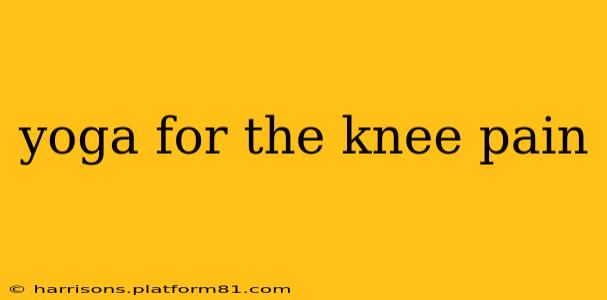Knee pain can significantly impact your quality of life, limiting mobility and causing discomfort. While medical attention is crucial for serious knee issues, many find relief and improved mobility through gentle yoga practices. This article explores how yoga can help manage knee pain, focusing on poses that strengthen supporting muscles, improve flexibility, and reduce inflammation. We'll also address common questions surrounding yoga and knee pain.
What Type of Yoga is Best for Knee Pain?
Finding the right yoga style is paramount. Avoid styles like Ashtanga or Power Yoga, which involve intense, fast-paced movements that can aggravate knee pain. Instead, focus on gentler styles like:
- Hatha Yoga: This foundational style emphasizes slow, deliberate movements and breathwork, ideal for building strength and flexibility without strain.
- Restorative Yoga: This calming practice uses props like bolsters and blankets to support the body in passive poses, promoting relaxation and reducing inflammation.
- Yin Yoga: This style holds poses for longer durations, targeting deep connective tissues and improving joint mobility. However, it's crucial to listen to your body and avoid any pose that causes sharp pain.
Always consult with your doctor or physical therapist before starting any new exercise program, especially if you have pre-existing knee conditions. A qualified yoga instructor can also help you modify poses to suit your individual needs and limitations.
Can Yoga Really Help with Knee Pain?
Yes, yoga can be a valuable tool in managing knee pain. By strengthening the muscles surrounding the knee joint (quadriceps, hamstrings, and calves), yoga improves stability and reduces strain. Furthermore, improving flexibility in the hips and hamstrings can alleviate pressure on the knees. The mindful breathing techniques incorporated in yoga can also help reduce stress and inflammation, which often contribute to knee pain.
What Yoga Poses are Good for Knee Pain?
Several yoga poses can be beneficial for knee pain, but always remember to listen to your body and stop if you feel any sharp pain. Here are a few examples:
- Child's Pose (Balasana): This restorative pose gently stretches the hips, thighs, and ankles, relieving pressure on the knees.
- Downward-Facing Dog (Adho Mukha Svanasana): While modifications might be necessary (bending the knees deeply), this pose strengthens the legs and improves flexibility in the hamstrings.
- Cat-Cow Pose (Marjaryasana to Bitilasana): This gentle flow improves spine mobility and can help reduce stiffness in the lower back, which often contributes to knee pain.
- Tree Pose (Vrksasana): This balancing pose, modified with a chair or wall for support if needed, strengthens leg muscles and improves balance, which is crucial for knee stability.
- Supported Reclined Butterfly Pose (Supta Baddha Konasana): This restorative pose opens the hips and inner thighs, relieving tension that may contribute to knee pain.
How Often Should I Do Yoga for Knee Pain?
The frequency of yoga practice depends on your individual needs and tolerance. Starting with 2-3 sessions per week for 30-45 minutes is a good starting point. Gradually increase the duration and frequency as your strength and flexibility improve. Consistency is key, so aim for regular practice to experience the full benefits.
Are There Any Yoga Poses I Should Avoid with Knee Pain?
Yes, certain yoga poses can exacerbate knee pain. Avoid poses that put excessive stress on the knees, such as:
- Lotus Pose (Padmasana): This deep seated pose requires significant hip and knee flexibility, which might be problematic for those with knee pain.
- Hero Pose (Virasana): This kneeling pose can put considerable pressure on the knees.
- Pigeon Pose (Kapotasana): This hip-opening pose can be challenging for knees with existing issues. Modifications are possible, but proceed with caution.
What are the Risks of Doing Yoga with Knee Pain?
While yoga can be beneficial, it’s crucial to practice safely. Improper form or pushing yourself too hard can worsen knee pain. Listen to your body, modify poses as needed, and don't hesitate to seek guidance from a qualified yoga instructor experienced in working with individuals with knee pain.
Remember, this information is for general knowledge and doesn't constitute medical advice. Always consult with your healthcare provider before starting any new exercise program, especially if you have a pre-existing condition like knee pain. A combined approach of medical treatment and gentle yoga practice can often lead to significant improvement in managing knee pain and regaining mobility.
